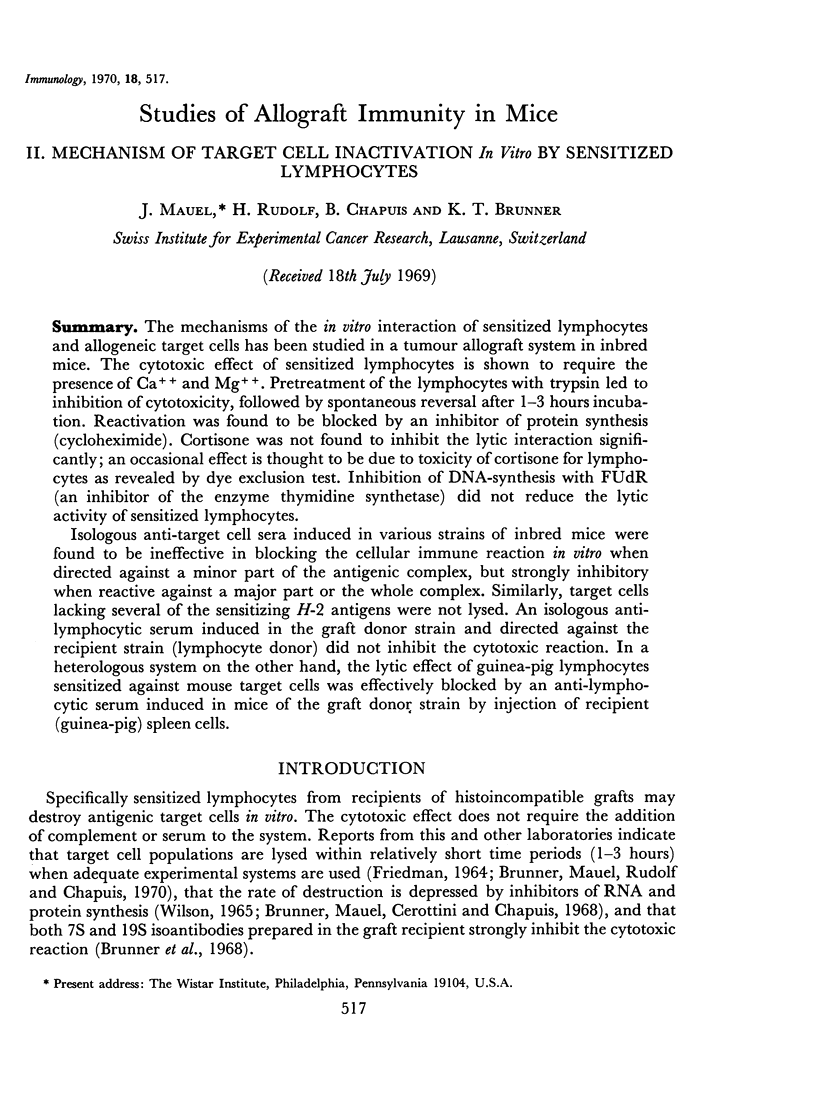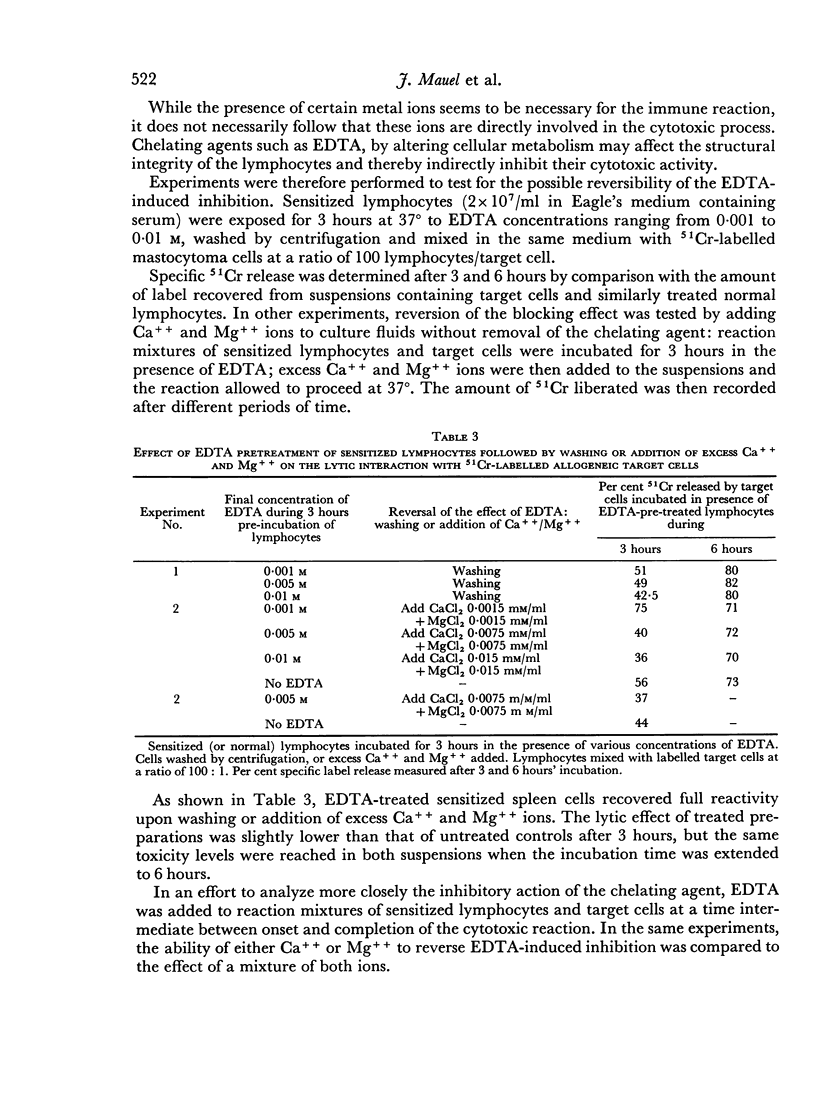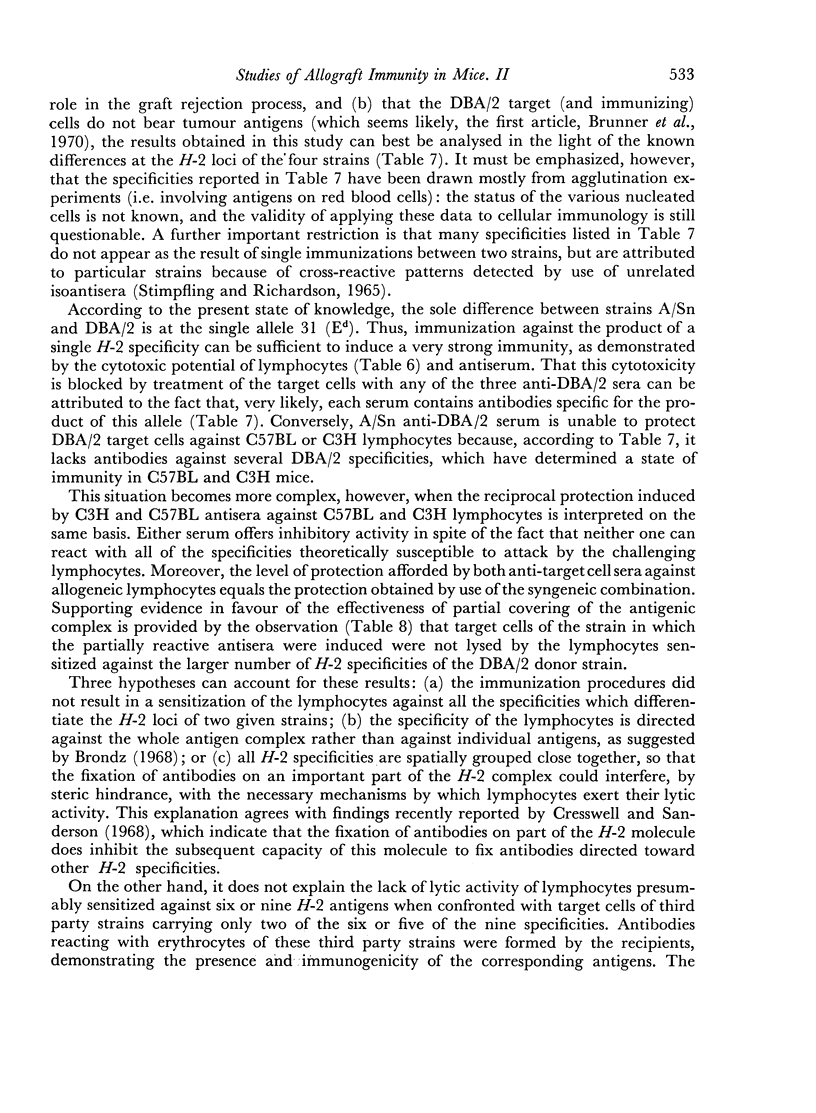Abstract
The mechanisms of the in vitro interaction of sensitized lymphocytes and allogeneic target cells has been studied in a tumour allograft system in inbred mice. The cytotoxic effect of sensitized lymphocytes is shown to require the presence of Ca+ + and Mg+ +. Pretreatment of the lymphocytes with trypsin led to inhibition of cytotoxicity, followed by spontaneous reversal after 1–3 hours incubation. Reactivation was found to be blocked by an inhibitor of protein synthesis (cycloheximide). Cortisone was not found to inhibit the lytic interaction significantly; an occasional effect is thought to be due to toxicity of cortisone for lymphocytes as revealed by dye exclusion test. Inhibition of DNA-synthesis with FUdR (an inhibitor of the enzyme thymidine synthetase) did not reduce the lytic activity of sensitized lymphocytes.
Isologous anti-target cell sera induced in various strains of inbred mice were found to be ineffective in blocking the cellular immune reaction in vitro when directed against a minor part of the antigenic complex, but strongly inhibitory when reactive against a major part or the whole complex. Similarly, target cells lacking several of the sensitizing H-2 antigens were not lysed. An isologous anti-lymphocytic serum induced in the graft donor strain and directed against the recipient strain (lymphocyte donor) did not inhibit the cytotoxic reaction. In a heterologous system on the other hand, the lytic effect of guinea-pig lymphocytes sensitized against mouse target cells was effectively blocked by an anti-lymphocytic serum induced in mice of the graft donor strain by injection of recipient (guinea-pig) spleen cells.
Full text
PDF


















Selected References
These references are in PubMed. This may not be the complete list of references from this article.
- Brondz B. D., Bartova L. M. Study of the influence of certain factors on the activity of lymphocytes in allogeneic macrophage cultures. Folia Biol (Praha) 1966;12(6):431–441. [PubMed] [Google Scholar]
- Brondz B. D. Complex specificity of immune lymphocytes in allogeneic cell cultures. Folia Biol (Praha) 1968;14(2):115–131. [PubMed] [Google Scholar]
- Brunner K. T., Mauel J., Cerottini J. C., Chapuis B. Quantitative assay of the lytic action of immune lymphoid cells on 51-Cr-labelled allogeneic target cells in vitro; inhibition by isoantibody and by drugs. Immunology. 1968 Feb;14(2):181–196. [PMC free article] [PubMed] [Google Scholar]
- Cresswell P., Sanderson A. R. Spatial arrangement of H-2 specificities: evidence from antibody adsorption and kinetic studies. Transplantation. 1968 Dec;6(9):996–1004. doi: 10.1097/00007890-196812000-00006. [DOI] [PubMed] [Google Scholar]
- DAVID J. R., LAWRENCE H. S., THOMAS L. THE IN VITRO DESENSITIZATION OF SENSITIVE CELLS BY TRYPSIN. J Exp Med. 1964 Dec 1;120:1189–1200. doi: 10.1084/jem.120.6.1189. [DOI] [PMC free article] [PubMed] [Google Scholar]
- FRIEDMAN H. INHIBITION OF ANTIBODY PLAQUE FORMATION BY SENSITIZED LYMPHOID CELLS: RAPID INDICATOR OF TRANSPLANTATION IMMUNITY. Science. 1964 Aug 7;145(3632):607–609. doi: 10.1126/science.145.3632.607. [DOI] [PubMed] [Google Scholar]
- LICHTENSTEIN L. M., OSLER A. G. STUDIES ON THE MECHANISMS OF HYPERSENSITIVITY PHENOMENA. IX. HISTAMINE RELEASE FROM HUMAN LEUKOCYTES BY RAGWEED POLLEN ANTIGEN. J Exp Med. 1964 Oct 1;120:507–530. doi: 10.1084/jem.120.4.507. [DOI] [PMC free article] [PubMed] [Google Scholar]
- Marney S. R., Jr, Des Prez R. M. Comparison of the effects of divalent ion chelating agents on complement-mediated hemolysis in rabbit and human serum. J Immunol. 1969 Nov;103(5):1044–1049. [PubMed] [Google Scholar]
- Möller E. Cytotoxicity by nonimmune allogeneic lymphoid cells. Specific suppression by antibody treatment of the lymphoid cells. J Exp Med. 1967 Aug 1;126(2):395–405. doi: 10.1084/jem.126.2.395. [DOI] [PMC free article] [PubMed] [Google Scholar]
- Perlmann P., Perlmann H., Holm G. Cytotoxic action of stimulated lymphocytes on allogenic and autologous erythrocytes. Science. 1968 Apr 19;160(3825):306–309. doi: 10.1126/science.160.3825.306. [DOI] [PubMed] [Google Scholar]
- Perlmann P., Perlmann H., Müller-Eberhard H. J., Manni J. A. Cytotoxic effects of leukocyres triggered by complement bound to target cells. Science. 1969 Feb 28;163(3870):937–939. doi: 10.1126/science.163.3870.937. [DOI] [PubMed] [Google Scholar]
- ROSENAU W., MOON H. D. The inhibitory effect of hydrocortisone on lysis of homologous cells by lymphocytes in vitro. J Immunol. 1962 Sep;89:422–426. [PubMed] [Google Scholar]
- STIMPFLING J. H., RICHARDSON A. RECOMBINATION WITHIN THE HISTOCOMPATIBILITY LOCUS OF THE MOUSE. Genetics. 1965 May;51:831–846. doi: 10.1093/genetics/51.5.831. [DOI] [PMC free article] [PubMed] [Google Scholar]
- WILSON D. B. QUANTITATIVE STUDIES ON THE BEHAVIOR OF SENSITIZED LYMPHOCYTES IN VITRO. II. INHIBITORY INFLUENCE OF THE IMMUNE SUPPRESSOR, IMURAN, ON THE DESTRUCTIVE REACTION OF SENSITIZED LYMPHOID CELLS AGAINST HOMOLOGOUS TARGET CELLS. J Exp Med. 1965 Jul 1;122:167–172. doi: 10.1084/jem.122.1.167. [DOI] [PMC free article] [PubMed] [Google Scholar]


